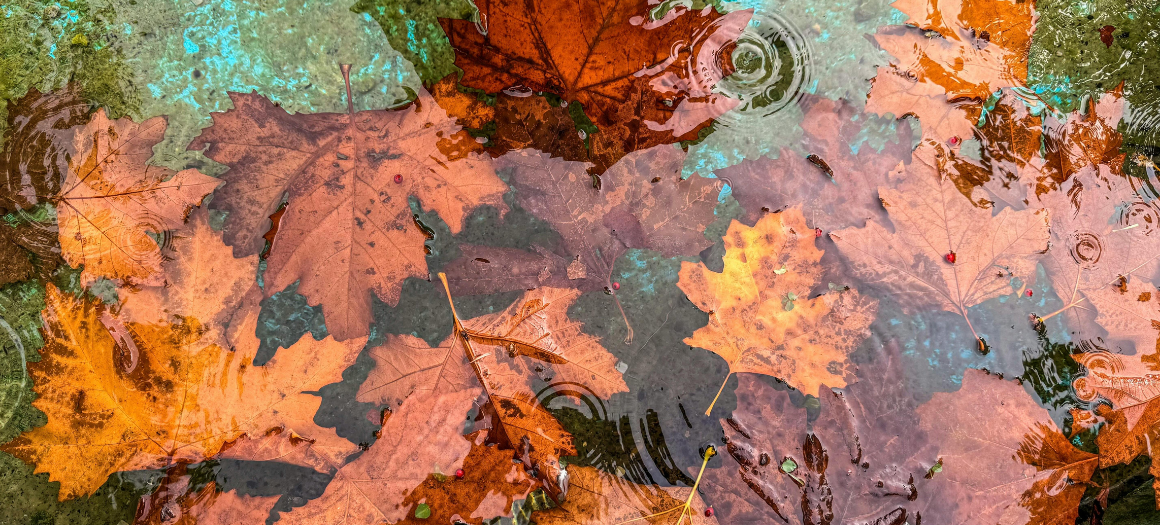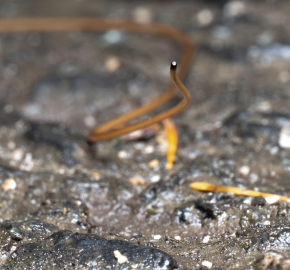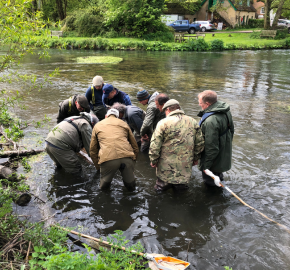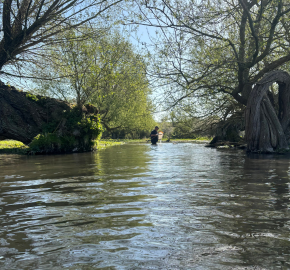The role of autumn leaves in freshwater ecosystems

We have officially entered autumn, and the first leaves have started to fall. Have you ever wondered what happens to them when they land in streams, rivers and ponds? How are they decomposed, what creatures perform this crucial task, and why does it matter?
In this blog, we explore what is technically known as leaf litter decomposition – the process where fallen leaves are broken down and enrich river ecosystems.
Leaf litter: a vital source of energy for aquatic invertebrates
Many organisms living in freshwaters depend on external sources of energy to survive, and leaves from the surrounding riparian vegetation are the most important.
Leaves that fall into rivers, lakes and streams are colonised and transformed by microorganisms first (bacteria and fungi) and/or broken into smaller fragments by a specific group of macroinvertebrates: the shredders. These include some species of stoneflies, caddisflies, crane flies, crayfish, shrimps, water hog lice and some molluscs. The smaller leaf fragments are then eaten by a second group: detritivores or collectors, including beetles, black flies, non-biting midges, mayflies, stoneflies and caddisflies. The shredders are not just breaking down leaves for others to eat! They graze on the microbes that grow on the leaves, while also ingesting some leaf tissue. In fact, they prefer leaves that have been colonised by fungi and bacteria; this colonisation process is known as ‘conditioning’.
These aquatic invertebrates are a vital part of the freshwater food web. They provide an essential food source for fish and other wildlife. Anything which affects invertebrate health, like the availability and suitability of leaf litter, can ultimately impact fish populations.
Pressures impacting leaf litter decomposition
1. Invasive Species
Since different trees produce different types of leaves, the composition of the riparian vegetation has a strong influence on the communities of aquatic macroinvertebrates found in a river (and shredders in particular). Some non-native species of trees such as Eucalyptus globulus produce leaves with a thick cuticle that makes them difficult to eat, this is also the case of Sitka spruce (Picea sitchensis) needles, the dominant plantation species used in Britain.
Furthermore, Eucalyptus leaves have substances called phenols that are toxic for some aquatic invertebrates, including the Cranefly (Tipula lateralis) and the Welshman’s Button Caddisfly (Sericostoma personatum).
Litterfall varies between seasons and among species and types of trees (deciduous versus perennial). Sometimes shredders can adapt to these changes, by feeding on other sources of food, for example, debris retained by fallen trees (important in coniferous forest streams), overhanging grasses, fragments of aquatic plants and green algae. This is known as feeding plasticity.
2. Physical Structures
Physical structures in streams and rivers can affect the decomposition of leaves. Dams, for example, increase turbidity and water temperature in the reservoir section, resulting in lower biomass of the microorganisms that are responsible for the initial degradation of leaves and the potential elimination of some temperature-intolerant species of shredders.
3. Climate Change
Climate change is increasing global temperature, the frequency of extreme events and shifting seasons, all of which have mixed effects on freshwaters. Warmer temperatures generally speed up microbial metabolism, increasing decomposition rates. On the other hand, they reduce oxygen levels or even water availability during droughts, slowing leaf decomposition despite the increased microbial potential.
Earlier springs and delayed autumns can create a mismatch between the timing of leaf fall and the peak of the microbial activity, leading to asynchronous decomposition, affecting nutrient availability and carbon dynamics. Moreover, climate change rarely acts alone, it interacts with multiple stressors such as nutrient pollution, invasive species, and land-use changes, creating even more complex outcomes.
Preserving good leaf litter
Leaves are a very important food source for invertebrates. There are several measures that can be implemented in our rivers to support this natural process and combat the pressures, including:
1. The addition of woody debris
Logs, branches, twigs and other structures can increase channel roughness (e.g., rocks and cobbles), which in turn increases leaf retention.
2. Restoration of riparian corridors
Another measure is the preservation of riparian corridors with a variety of native species of trees, avoiding non-native species and monocultures. This will help to ensure an input of different types of leaves, without toxic components, that can be easily processed by the local fauna of aquatic microorganisms and invertebrates.
Informed conservation
Good water quality is essential for sustaining freshwater life. The retention and input of leaf litter plays a key role in these ecosystems, providing energy and materials for aquatic invertebrates. Understanding these invertebrate communities and the factors that influence their survival is vital if we are to restore and protect rivers.
Through SmartRivers, our volunteers sample and analyse aquatic invertebrates at 243 river sites across the UK. These species act as indicators of water quality, and the data collected helps build a picture of river health, informing the urgent action needed. Follow the link below, to find out more about SmartRivers.
Explore SmartRivers
So, the next time you walk by a river in autumn, think about how leaves link land and water. They are a beautiful example of how everything in nature is amazingly connected and a vital source of energy for the aquatic invertebrates that fish depend on.
References
Abelho, M. and Graça, M.A.S. (1996) Effects of Eucalyptus afforestation on leaf litter dynamics and macroinvertebrate community structure of streams in Central Portugal. Hydrobiologia 324, 195–204. https://doi.org/10.1007/BF00016391
Canhoto, C. and Graca, M.A.S. (1995) Food value of introduced eucalypt leaves for a Mediterranean stream detritivore, Tipula lateralis. Freshwater Biology, 34: 209-214.
Cummins, K.W., Wilzbach, M.A., Gates, D.M., Perry, J.B. and Taliafenro, W.B. (1989) Shredders and riparian vegetation. BioScience, 39(1): 24-30. https://doi.org/10.2307/1310804
Friberg, N. and Jacobsen, D. (1994) Feeding plasticity of two detritivore shredders. Freshwater Biology, 32: 133-142. Available at: https://www.researchgate.net/publication/230191738_Feeding_plasticity_of_detritivore_shredders (accessed: 03/10/2025).
Graça, M. (2001) The Role of Invertebrates on Leaf Litter Decomposition in Streams – a Review. International Review of Hydrobiology. 86. doi: 10.1002/1522-2632(200107)86:4/5<383::AID-IROH383>3.0.CO;2-D
Hare, D.K., Helton, A.M., Cummins, C.S., Bumpers, P.M., Tomczyk, N.J., Rogers, P.A., Wenger, S.J., Hotchkiss, E.R., Rosemond, A.D. and Benstead, J.P. (2024) Leaf litter breakdown phenology in headwater stream networks is modulated by groundwater thermal regimes and litter type. Limnology and Oceanography Letters, 9: 532–542. doi: https://doi.org/10.1002/lol2.10423
Migliorini, G.H. and Romero, G.Q. (2020) Warming and leaf litter functional diversity, not litter quality, drive decomposition in a freshwater ecosystem. Scientific Reports, 10: 20333. doi: https://doi.org/10.1038/s41598-020-77382-7
Rivas-Torres, A., Graça, M.A.S., Landeira-Dabarca, A., Álvarez, M., Juen, L. and Cordero-Rivera, A. Eucalyptus globulus Afforestation Reduces Invertebrate Richness and Diversity in Streams (2025). Hydrobiology, 4(2): 16. doi: https://doi.org/10.3390/hydrobiology4020016
Pretty, J.L. and Dobson, M. (2004) Leaf transport and retention in a high gradient stream. Hydrology and Earth System Sciences, 8(3): 560-566. Available at: https://hess.copernicus.org/articles/8/560/2004/hess-8-560-2004.pdf (accessed: 03/10/2025).
Prota Salomão, V., Tonin, A.M., de Souza Rezende, R., Figueiredo Marques Leite, G., Araújo Cunha Carvalho Alvim, E., Brandão Quintão, J.M. and Gonçalves Júnior, J.F. (2019) Small dam impairs invertebrate and microbial assemblages as well as leaf breakdown: a study case from a tropical savanna stream. Limnologica, 77, 125685. doi: https://doi.org/10.1016/j.limno.2019.125685
Sanchez, J. A. (2019) Effects of Climate Variability: A Long-term Perspective on Leaf Litter Processing in the Ogeechee River. Master’s Thesis, Georgia Southern University. Available at: https://digitalcommons.georgiasouthern.edu/etd/1983 (accessed: 07-10-25).
Scholl, E.A., Hanus, K.H., Gardner, T.W. and Kennedy, T.A. (2024) Multiple stressors mediate the effects of warming on leaf decomposition in a large regulated river. Ecosphere, 15(3), e4804. doi: https://doi.org/10.1002/ecs2.4804




